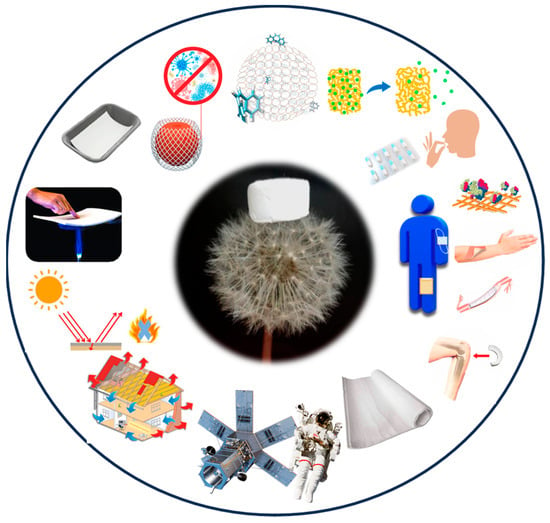You're using an outdated browser. Please upgrade to a modern browser for the best experience.
Please note this is a comparison between Version 1 by Antonella Caterina Boccia and Version 2 by Rita Xu.
An increasing number of aerogels as nanostructured highly porous materials are entering the market in every day products, with an attractive portfolio of properties for emerging applications ranging from health care and leisure to electronics, cosmetics, energy, agriculture, food and environmental.
- best practices
- safety regulatory compendium
- aerogels
1. Introduction
Aerogels are a special class of nanostructured materials generally with an ultra-light weight and high porosity, associated with tunable physicochemical properties [1]. Kistler reported, for the first time, the term aerogel in 1931, defining it as a low-density, porous solid gel derived from gel [2]. To date, the definition of aerogels lies in a sort of “limbo”, considering that IUPAC defines aerogels as “a gel comprised of microporous solid in which the dispersed phase is gas” [3], but the scientific community stated that aerogels are not strictly microporous solids as there are commonly reported mesoporous and nanofibril aerogels [4]. In the meantime, aerogels cannot be considered nanoforms, based on the REACH Annexes definition [5][6][5,6], and they are also exempted from the need to report to national nanomaterials product inventories such as those in France, Belgium, the USA or Canada [7][8][7,8]; but, they can be included in the nanomaterials category considering that they are constituted by nanomaterials [9]. Typically, aerogels are obtained through a sol-gel process [10], meaning that a colloidal suspension of precursors was converted by applying a gelling process, after which the replacement of the solvent with gas into materials characterized by a three-dimensional network follows. According to the nature of the solvent occupying the solid scaffold, as well as on the procedure commonly used for the solvent replacement, it is possible to produce: (i) aerogels (usually obtained by CO2 supercritical drying) [2][11][2,11]; (ii) xerogels (usually obtained by atmospheric pressure drying) [12][13][12,13]; and (iii) cryogels (usually obtained by freeze drying) [14], which are materials characterized by different properties and are accepted with the general term “aerogel”. The main sources for fabricating the aerogels are silica, alumina and carbon, but synthetic polymers, biopolymers and other organic precursors need to be considered as emerging sources. In recent years, aerogels are increasingly being studied considering the appealing applications in food, for the controlled release of active compounds, biomedical, textile, packaging, energy storage devices, aerospace engineering, and solar-steam generation [15][16][17][15,16,17], as illustrated in Figure 1, but the full potential of aerogels is still to be assessed for other technological sectors [18][19][18,19]. As materials for biomedical applications, they are able to respond to the requirement for tissue engineering applications, such as in designing implantable cardiovascular devices, as well as for nerve repair implant applications, bone grafting and biosensing [20]. The adaptable surface area, together with the surface functionalization, makes them valuable candidates to be used as a platform for adsorbing and controlling the release of active compounds. For specific administration routes, aerogels are capable to improve the delivery of low water soluble drugs and deliver, in situ, the drug enhancing the bioavailability [21]. Concerning aerogels in textiles, they received attention in this century for producing protective clothing for space exploration, as the first application, and successively for thermal insulation textiles [22]. Recently, the new emerging applications include aerogels as textiles for wound care medical applications [23][24][23,24], face masks [25] and tissue engineering applications [26][27][26,27], thermal insulating [28], smart clothes, prevention of electromagnetic radiation, protection against chemicals, flame retardancy and treatment of textile process wastes [29][30][29,30]. Regarding the environmental applications, aerogels are ideal materials for thermal insulations which can save energy and help to reduce carbon emissions due to their low thermal conductivity. Another aspect to be considered is that aerogels generally possess a high porosity and specific surface area, enabling them to be ideal materials useful to adsorb toxic molecules or ions in the air and water, which can be applied to protect the environment [31]. As a consequence, the aerogels market has recently seen a surge in the number of patents filed on aerogels, demonstrating the incredible increase on these materials in recent years. Even considering that the market is mainly driven by the increasing demand for construction applications, the new emerging trend, together with increases in R&D investment and a global aerogel market size projected to reach USD 1045 million by 2025, suggests that the market believes aerogels will become increasingly important [32][33][32,33].

Figure 1.
Aerogel-based materials for biomedical, textile, packaging, energy storage devices, solar-steam generation, and aerospace engineering applications.
To date, there is a lack of information concerning the toxicity of aerogels; ecotoxicity and cytotoxicity and regarding the health risk assessment and other regulatory aspects are not extensively addressed as aerogels do not require registration as nanoforms but their nanostructures raise concerns about a possible hazard assessment which needs to be addressed. The reason for this may be partially due to an uncertainty about which aspects should be approached for regulatory purposes. However, producers cannot neglect that even if the toxicity inherent to aerogel exposure is not expected in general, an increased bioactivity may derive from inhalable or ingestible fragments due to their high inner surface area [34]. One of the most critical routes of exposure to aerogel nanoparticles is the unintended inhalation of material dust and the consequent pulmonary deposition, which is an existing scenario in the industrial insulation production of silica and PU-based (PU = polyurethanes) aerogel materials [35], as well as during the installation and removal activities of insulation materials in houses, considering that this is one of the most frequent applications. It is important to keep in mind that for the industrial implementation of aerogels all workers involved in the production process and application of aerogels may be involved in the exposure to these nanostructures and the dispersion into the surrounding environment, and, consequently, global regulation is highly necessary to prevent any risks to human health.
